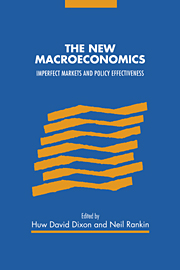Book contents
- Frontmatter
- Contents
- List of contributors
- Preface
- Acknowledgements
- Introduction
- Part I Overviews and perspectives
- Part II Goods market imperfections
- 4 Optimal labour contracts and imperfect competition: a framework for analysis
- 5 Market power, coordination failures and endogenous fluctuations
- 6 Macroeconomic externalities
- Part III Labour market imperfections
- Part IV Financial market imperfections
- Part V Nominal rigidities and bounded rationality
- Bibliography
- Index of authors
- Index of subjects
6 - Macroeconomic externalities
Published online by Cambridge University Press: 13 October 2009
- Frontmatter
- Contents
- List of contributors
- Preface
- Acknowledgements
- Introduction
- Part I Overviews and perspectives
- Part II Goods market imperfections
- 4 Optimal labour contracts and imperfect competition: a framework for analysis
- 5 Market power, coordination failures and endogenous fluctuations
- 6 Macroeconomic externalities
- Part III Labour market imperfections
- Part IV Financial market imperfections
- Part V Nominal rigidities and bounded rationality
- Bibliography
- Index of authors
- Index of subjects
Summary
Introduction
In recent years, researchers have made a great deal of progress in the quest for Keynesian models with rigorous microeconomic foundations. It is now well understood that macroeconomic models incorporating imperfect competition or search frictions can give rise to ‘Keynesian features’, such as inefficiency, multipliers and coordination failures, without recourse to unexplained price rigidities. The seminal contributions are Hart (1982) for models with imperfect competition, and Diamond (1982) for search models.
The ability of both types of model to exhibit Keynesian features can be understood in terms of an underlying structural similarity: both imperfect competition and search in macroeconomic models lead to strategic complementarities. But this similarity does not imply that the models are perfect substitutes, either in terms of interpretation or in terms of the questions that they can address. Search frictions are particularly plausible in labour markets, and allow for explicit discussion of unemployment. Imperfect competition, conversely, is appealing for analysis of output markets; some empirical work supports this view.
Thus it comes as no surprise – indeed it is desirable – that researchers continue to investigate both paradigms. It is perhaps more surprising that these two branches of the literature still coexist in relative isolation from one another. One goal of the current work is to facilitate communication between these approaches by further identifying some of their formal similarities and substantive differences in a framework where both distortions can be understood as a source of externality.
- Type
- Chapter
- Information
- The New MacroeconomicsImperfect Markets and Policy Effectiveness, pp. 139 - 170Publisher: Cambridge University PressPrint publication year: 1995
- 1
- Cited by



